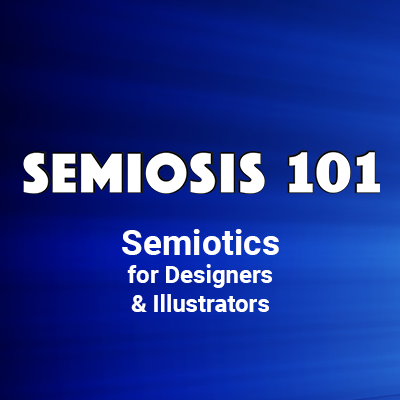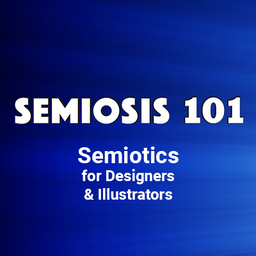BLOG 10: Semiotically Affecting Your Audience’s Thinking

Semiosis 101 - 5 minute semiotic read
You designers and illustrators need your target audience.
The semiotic determination flow in Semiosis is not an “ideal concept” flowing to an “ideal representation.” Peirce’s pragmatic Semiosis is unlike Saussure’s linguistic-based Semiology of signifier/signified. Yes, Semiosis can be described as having these two interlocking directional courses too. The concept to be represented (signified), and the representation (signifier) of the concept.
However, it is Peirce’s Semiosis as a semiotic theory, unlike Saussure’s Semiology, which goes beyond a pre-set philosophical “ideal” concept of what is an “ideal” representation. Peirce knows that interpretation is open-ended. Two people can see an illustration or design and
disagree on what they see and understand. For interpretation to be made of the intended concept from the representation in a semiotic sign, meaning cannot just be left vulnerable to audience misinterpretation.
The determination of meaning in a semiotic sign, flows through the sign to the target audience.
In Semiosis, the two interlocking directional courses of concept to representation, and the representation to the concept, has a third important component that Saussure’s Semiology does not. The interpreter.
More accurately, the effect of the interpretation on the thoughts and action of the audience. The determination flow in semiotic sign-action flows THROUGH the representation to the audience.
Now, semiotically un-mediated, your audience could interpret many tangental alternative meanings, from what they see, in your visual representation in the semiotic sign.
So as illustrators and designers, to visually communicate the concept your client needs you to convey to the target audience, you need to structure the effect of the interpretation, to ensure the intended concept is what is interpreted.
The effect of what is represented on the interpretation in the mind of the audience can be determined.
The determination flow of Semiosis is usually diagrammed as an inverted pyramid, with concept (Peirce’s Object) top left; the representation of the concept (Peirce’s Representamen) at the bottom; and the interpretation (Peirce’s Interpretant) top right of the inverted pyramid. The determined relationship of the flow of meaning from one to the next, in the diagram is anti-clockwise.
The concept flows through the representation to make an interpretation. Semiosis does not end there. The determined flow needs to return to the concept. The audience’s interpretation needs to be semiotically mediated to offer limited latitude for the TARGET audience to interpret anything but the concept.
Semiosis - semiotic sign-action - is structured to reinforce that interpretation of the concept.
When I use the term “semiotic sign” I am referring to your encoding of mindful meaning within your visual language.
In design and illustration, you may prefer to frame this as… ‘setting the tone,’ ‘tone of voice,’ or ‘branding guidelines,’ or ‘colour palettes,’ or ‘creating the mood,’ or ‘a visual style,’ or ‘the aesthetic,’ etc. You do this tacitly, but I’m going to let you into a big secret.
You have already been working semiotically to do this. You just were not aware that was what you have been doing.
Now Semiosis offers you a way to structure your visual language, to visually communicate intended meaning more effectively to your target audience. This determination flow of concept > representation > interpretation is just the mechanics of semiotic sign-action.
The action is the effect on your audience.
So, how do you illustrators and designers limit your audience’s latitude to misinterpret meaning? How do you get them to interpret the concept your client wants to convey?
The effect on the thoughts of the audience of the representation you use - your visual language choices - needs to consider appropriate context. You can help the audience to interpret the intended concept, if you let the audience help you.
Yes, you read that correctly. Your audience can help you contextualise appropriate visual language decisions. The audience draws on previous lived experiences to construct new understanding. Your encoded semiotic signs, within your visual language, are “external signs” in PERCEPTIBLE FORMS. The audience’s thoughts of what the representation could mean form mental ideas, which are “internal signs” that construct understanding.
Semiosis’ determination flow mediates your audience’s thinking too!





